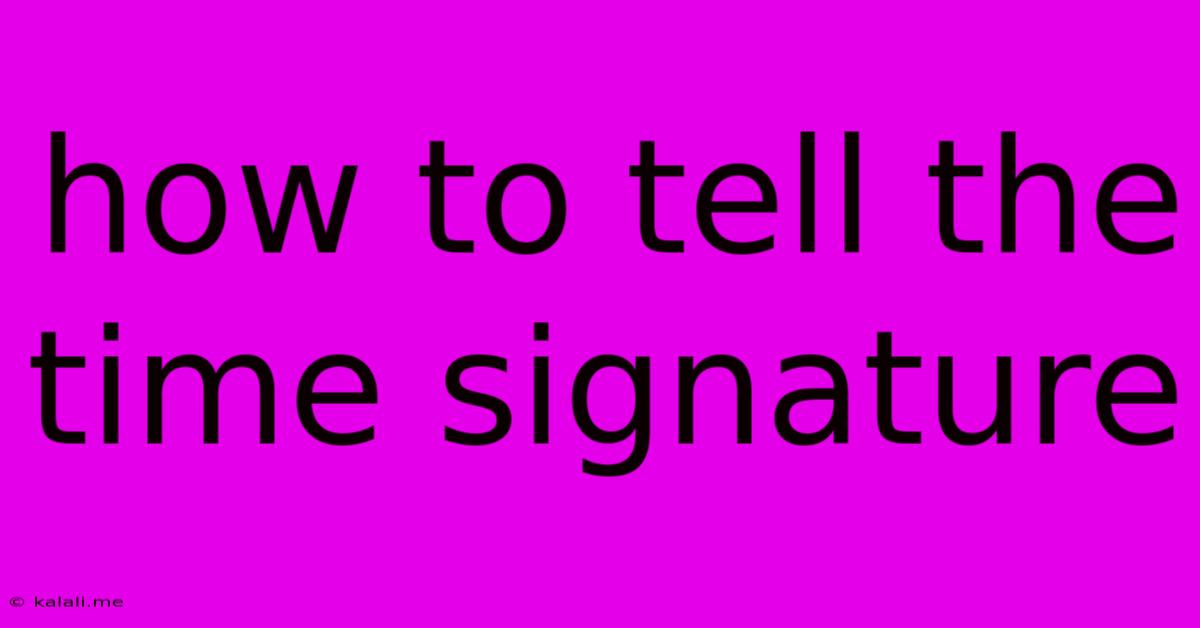How To Tell The Time Signature
Kalali
May 28, 2025 · 3 min read

Table of Contents
How to Tell the Time Signature: A Beginner's Guide to Understanding Musical Meter
Understanding time signatures is crucial for musicians of all levels. This guide will walk you through the basics of recognizing and interpreting time signatures, helping you decipher the rhythmic structure of any piece of music. This article will cover what time signatures represent, how to identify them on sheet music, and some common examples to help solidify your understanding.
Time signatures, located at the beginning of a musical piece, dictate the number of beats in each measure and the type of note that receives one beat. This information is vital for understanding the rhythmic pulse and feel of the music.
Understanding the Two Numbers
A time signature consists of two numbers, stacked vertically. The top number indicates how many beats are in each measure, while the bottom number indicates which note value receives one beat.
-
The Top Number (Beats per Measure): This number tells you how many beats are contained within each measure of music. A measure is a segment of music separated by bar lines. For example, a "4" means there are four beats in each measure.
-
The Bottom Number (Beat Unit): This number indicates the type of note that receives one beat.
- 4: A quarter note (♩) receives one beat.
- 2: A half note (♩) receives one beat.
- 8: An eighth note (♪) receives one beat.
- 16: A sixteenth note (𝅗𝅥) receives one beat.
Common Time Signatures and Their Feel
Let's explore some of the most common time signatures and what they sound like:
-
4/4 (Common Time): This is arguably the most common time signature. It means four beats per measure, and the quarter note gets one beat. It has a strong, steady feel often found in marches, pop songs, and many other genres. Think of a steady heartbeat – that's 4/4.
-
3/4 (Waltz Time): This time signature has three beats per measure, with the quarter note receiving one beat. It creates a graceful, flowing feel often associated with waltzes and similar styles of music. It has a smoother, more lyrical feel than 4/4.
-
2/4 (March Time): This time signature has two beats per measure, with the quarter note receiving one beat. It's often used for marches, simple folk songs, and some types of dance music. It has a more brisk and straightforward feel.
-
6/8 (Compound Time): While the top number is 6, this doesn't mean six distinct beats. It's a compound meter, meaning the beat is divided into three. There are two beats per measure, but each beat is subdivided into three eighth notes. This creates a more rhythmic and syncopated feel compared to 4/4 or 3/4.
Identifying Time Signatures on Sheet Music
Time signatures are always located at the beginning of a musical score, usually right after the clef and key signature. They're clearly visible and easily identifiable due to their distinct numerical format.
Look for two numbers, one above the other. Once you locate them, you can determine the number of beats per measure and the note value that receives one beat.
Beyond the Basics: Less Common Time Signatures
While the above examples cover the most common time signatures, you'll encounter others as your musical knowledge expands. These might include 5/4, 7/8, or even more complex meters. Understanding the core principles above allows you to approach and interpret these less common time signatures with confidence. The same principles apply – the top number indicates the number of beats, and the bottom indicates the type of note receiving one beat.
Practice Makes Perfect!
The best way to become proficient in reading and understanding time signatures is through practice. Listen to music in different time signatures, analyze the sheet music, and try tapping your foot along to the beat. With a little effort, you'll be a pro at deciphering musical meter in no time!
Latest Posts
Latest Posts
-
How To Install Washing Machine Drain Pan
May 30, 2025
-
How To Make Sure Different Meshes Move Together Blender Rig
May 30, 2025
-
How To Set A Pressure Switch On A Well
May 30, 2025
-
Gaussian Mixture Distribution Em Update Graphs
May 30, 2025
-
Please Let Me Know If These Are Sufficient
May 30, 2025
Related Post
Thank you for visiting our website which covers about How To Tell The Time Signature . We hope the information provided has been useful to you. Feel free to contact us if you have any questions or need further assistance. See you next time and don't miss to bookmark.